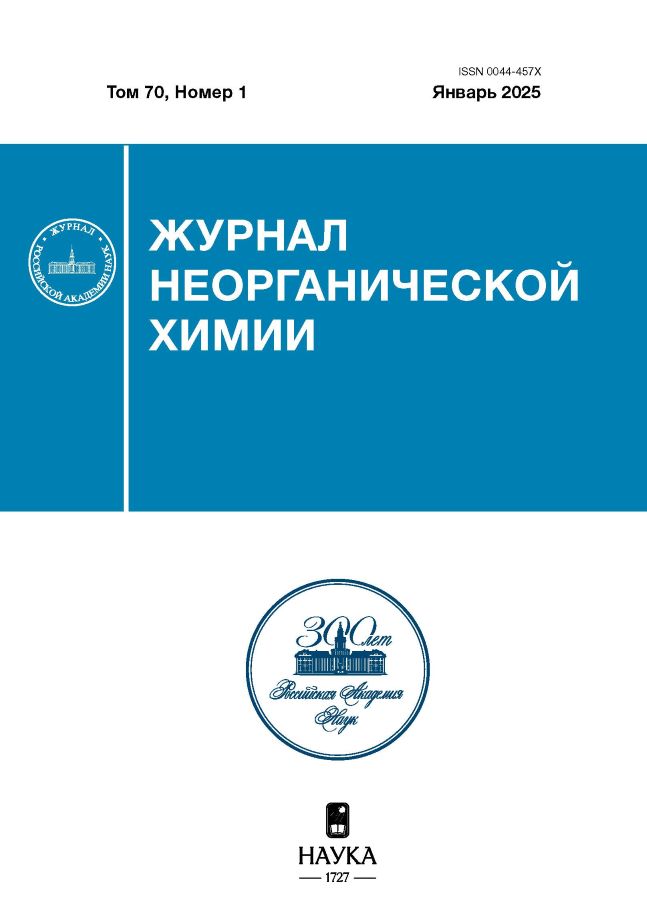Thermodynamic modeling of phase formation conditions in the system CuO–CO2–H2O–NH3
- 作者: Bublikova T.M.1, Setkova T.V.1, Balitsky V.S.1
-
隶属关系:
- Korzhinskii Institute of Experimental Mineralogy of the Russian Academy of Sciences
- 期: 卷 70, 编号 1 (2025)
- 页面: 91–101
- 栏目: ТЕОРЕТИЧЕСКАЯ НЕОРГАНИЧЕСКАЯ ХИМИЯ
- URL: https://ruspoj.com/0044-457X/article/view/682193
- DOI: https://doi.org/10.31857/S0044457X25010105
- EDN: https://elibrary.ru/CVIBYE
- ID: 682193
如何引用文章
详细
Phase formation in the CuO–CO2–H2O–NH3 system has been studied using thermodynamic modelling in the temperature range of 20–100°C, рo = 0.1 MPa and ammonia concentrations of 0, 0.01 and 2.0 mol/kg. The stability fields of tenorite [CuO], malachite [Cu2CO3(OH)2], azurite [Cu3(CO3)2(OH)2] were determined and the compositions of the solutions in equilibrium with the solid phases were calculated. The effect of temperature and ammonia concentration on the change in phase relations in the system was shown. It was found that during the interaction of tenorite, malachite and azurite with ammonia solutions 1.0–3.0 mol/kg, the copper content in the solution increased with increasing ammonia concentration and decreased with increasing temperature. The results presented provide a basis for understanding the mechanism of mineral formation in aqueous copper-carbonate systems, as well as for solving a number of environmental problems and developing technological processes for ammonia leaching.
全文:
作者简介
T. Bublikova
Korzhinskii Institute of Experimental Mineralogy of the Russian Academy of Sciences
编辑信件的主要联系方式.
Email: tmb@iem.ac.ru
俄罗斯联邦, Chernogolovka, 142432
T. Setkova
Korzhinskii Institute of Experimental Mineralogy of the Russian Academy of Sciences
Email: tmb@iem.ac.ru
俄罗斯联邦, Chernogolovka, 142432
V. Balitsky
Korzhinskii Institute of Experimental Mineralogy of the Russian Academy of Sciences
Email: tmb@iem.ac.ru
俄罗斯联邦, Chernogolovka, 142432
参考
- Смирнов С.С. Зона окисления сульфидных месторождений. Л.: Изд-во АН СССР, 1955. 231 с.
- Preis W., Gamsjäger H. // J. Chem. Thermodyn. 2002. V. 34. P. 631. http://dx.doi.org/10.1006/jcht.2002.0928
- Schindler P., Reinert M., Gamsjäger H. // Helv. Chim. Acta. 1968. V. 51. P. 1845. https://doi.org/10.1002/hlca.19680510805
- Symes J.L., Kester D.R. // Geochim. Cosmochim. Acta. 1984. V. 48. P. 2219. https://doi.org/10.1016/0016-7037(84)90218-7
- Puigdomenech I., Taxén C. Thermodynamic data for copper. Implications for the corrosion of copper under repository conditions. Technical Report SKB-TR-00-13. Stockholm, 2000. 96 p.
- Орехова Н.Н., Шадрунова И.В. Образование и комплексная переработка природно-техногенных вод при эксплуатации медно-цинково-колчеданных месторождений. Магнитогорск: Изд-во Магнитогорск. гос. техн. ун-та им. Г.И. Носова, 2015. 185 c.
- Обзор зарубежных практик захоронения ОЯТ и РАО / Под ред. Линге И.И., Полякова Ю.Д. М.: Изд-во Комтехпринт, 2015. 208 c.
- Arzutug M.E., Kocakerim M.M., Copur M. // Ind. Eng. Chem. Res. 2004. № 43. P. 4118. https://doi.org/10.1021/ie0342558
- Wang Xi, Chen Qiyuan, Huiping Hu et al. // Hydrometallurgy. 2009. № 99. P. 231. https://doi.org/10.1016/j.hydromet.2009.08.011
- Radmehr V., Koleni S.M.J., Khalesi M.R. et al. // J. Inst. Eng. India Ser. D. 2014. V. 94. P. 95. https://doi.org/10.1007/s40033-013-0029-x
- Aracena A., Vivar Y., Jerez O., Vásquez D. // Miner. Process. Extr. Metall. Rev. 2015. V. 36. P. 317. https://doi.org/10.1080/08827508.2015.1004404
- Aracena A., Pino J., Jerez O. // Metals. 2020. № 10. P. 833. https://doi.org/10.3390/met10060833
- Turan M.D., Ramazan O., Turan M. et al. // Mining, Metallurgy & Exploration. 2020. V. 37. P. 1349. https://doi.org/10.1007/s42461-020-00241-6
- Velásquez-Yévenes L., Ram R. // Cleaner Eng. Technol. 2022. V. 9. P. 100515. https://doi.org/10.1016/j.clet.2022.100515
- Panayotova М., Panayotov V. // J. Scient. Appl. Res. 2017. V. 11. P. 10.
- Shvarov Yu.V., Bastrakov E. HCh: a Software Package for Geochemical Equilibrium Modeling: User’s Guide (AGSO RECORD 1999/y). Canberra: Austr. Geol. Surv. Organisation; Dept. Industry, Science and Resources. 1999. 57 p.
- Русанов А.И. // Журн. общ. химии. 2022. Т. 92. № 4. С. 497. https://doi.org/10.31857/S0044460X22040011
- Рыженко Б.Н. Термодинамика равновесий в гидротермальных растворах. М.: Наука, 1981. 191 c.
- Helgeson H.C., Kirkham D.H., Flowers G.C. // Am. J. Sci. 1981. № 281. P. 1249. https://doi.org/10.2475/ajs.281.10.1249
- Бубликова Т.М., Балицкий В.С., Тимохина И.В. Синтез и основные свойства ювелирно-поделочного малахита. Синтез минералов. Т. 1. Александров, 2000. 662 c.
- Рыбникова Л.С., Рыбников П.А., Тютков О.В. // Водное хозяйство России. 2014. № 6. С. 77.
- Nienhuis J., Robbiola L., Giuliani R. et al. // e-Preservation Sci. 2016. V. 13. P. 23.
- Lytle D.A., Wahman D., Schock M.R. et al. // Chem. Eng. J. 2019. V. 355. P. 1. https://doi.org/10.1016/j.cej.2018.08.106
- Кочкин Б.Т., Мальковский В.И., Юдинцев С.В. Научные основы оценки безопасности геологической изоляции долгоживущих радиоактивных отходов (Енисейский проект). М.: ИГЕМ РАН, 2017. 384 c.
- Suzuki Y., Hisamatsu Y. // Corros. Sci. 1981. V. 21. P. 353.
- Зуев В.А., Букаты М.Б., Хафизов Р.Р. // Геоэкология. Инженерная геология, гидрогеология, геокриология. 2008. № 6. С. 531.
- Cole J.J., Prairie Y.T. // Reference Module Earth Systems Environ. Sci. 2014. https://doi.org/10.1016/b978-0-12-409548-9.09399-4
- Алексеева О.В., Смирнова Д.Н., Носков А.В. и др. // Журн. неорган. химии. 2023. Т. 68. № 8. С. 1021. https://doi.org/10.31857/S0044457X23600299
- Künkül A., Kocakerim M.M., Yapici S. et al. // Int. J. Miner. Process. 1994. V. 41. P. 167. https://doi.org/10.1016/0301-7516(94)90026-4
- Рудской А.И., Кузнецов Н.Т., Иванов В.К. и др. // Журн. неорган. химии. 2023. Т. 68. № 5. С. 694. https://doi.org/10.31857/S0044457X23600068
补充文件



















